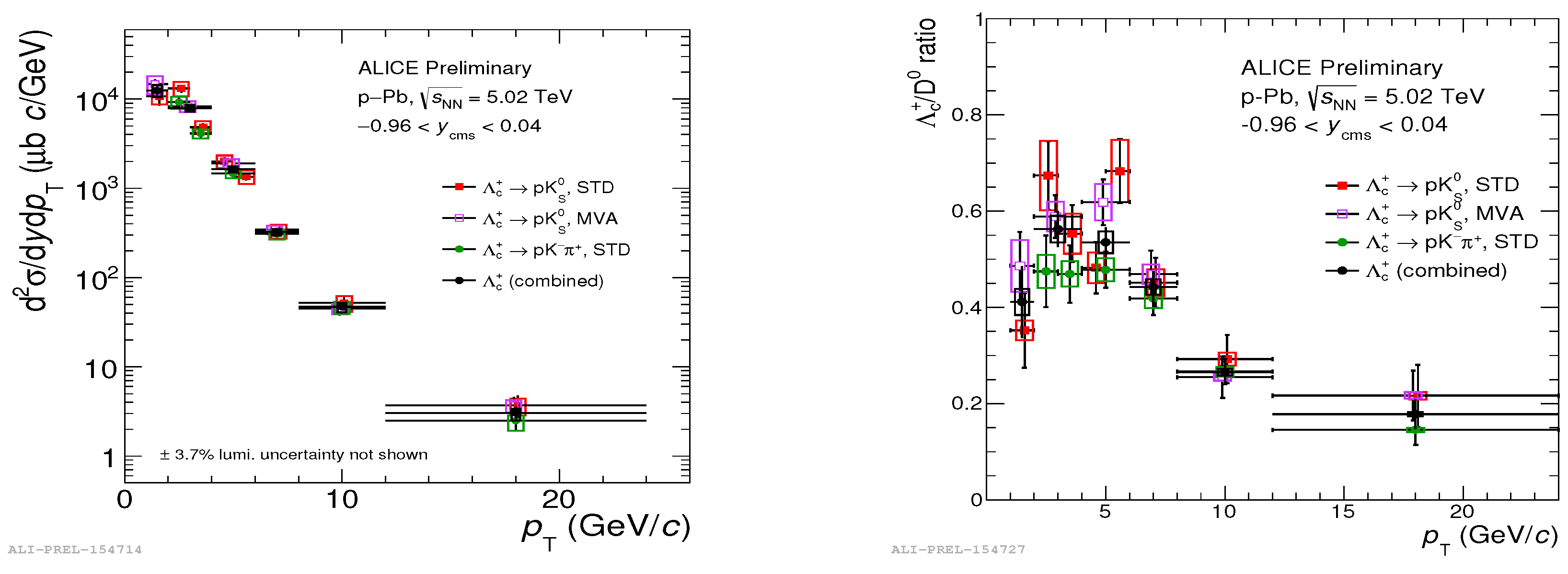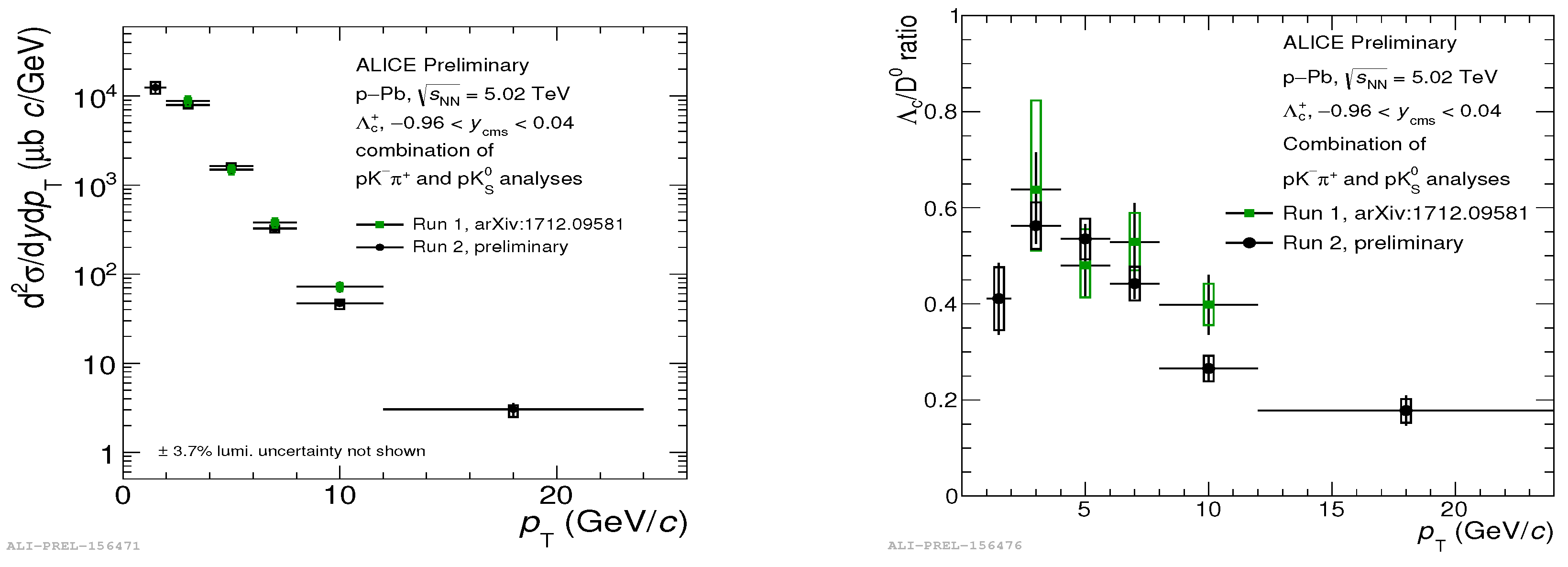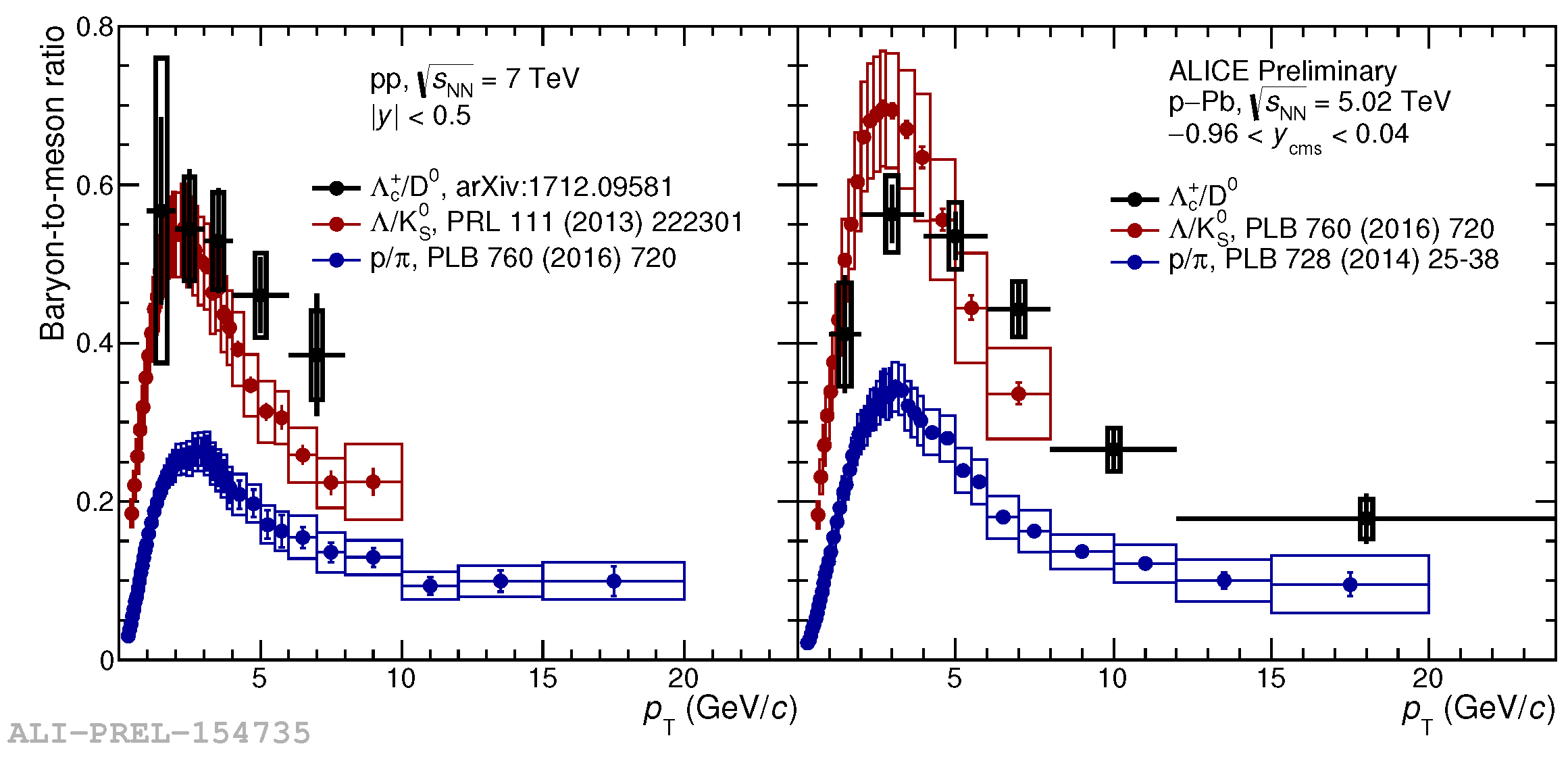Measurement of Λc+ Baryon Production in p–Pb Collisions with ALICE at the LHC †
Abstract
:1. Introduction
2. Data Analyses
3. Results
4. Discussion
5. Conclusions
Funding
Conflicts of Interest
References
- Adcox, K.; Adler, S.S.; Ajitanand, N.N.; Akiba, Y.; Alexander, J.; Aphecetche, L.; Arai, Y.; Aronson, S.H.; Averbeck, R.; Awes, T.C.; et al. Suppression of Hadrons with Large Transverse Momentum in Central Au + Au Collisions at 130 GeV. Phys. Rev. Lett. 2001, 88, 022301–022307. [Google Scholar] [CrossRef] [PubMed]
- Abelev, B.; Adam, J.; Adamova, D.; Adare, A.M.; Aggarwal, M.M.; Rinella, G.A.; Agnello, M.; Agocs, A.G.; Agostinelli, A.; Ahammed, Z.; et al. and Λ Production in Pb-Pb Collisions at 2.76 TeV. Phys. Rev. Lett. 2013, 111, 222301–222311. [Google Scholar] [CrossRef] [PubMed]
- Plumari, S.; Minissale, V.; Das, S.K.; Coci, G.; Greco, V. Charmed Hadrons from Coalescence plus Fragmentation in relativistic nucleus-nucleus collisions at RHIC and LHC. Eur. Phys. J. C 2018, 78, 348–361. [Google Scholar] [CrossRef]
- Yasui, S.; Lee, S.H.; Ohnishi, K.; Yoo, I.K.; Koi, C.M. Λc enhancement from strongly coupled QGP. Indian J. Phys. 2011, 85, 1043–1046. [Google Scholar] [CrossRef]
- Aamodt, K.; Quintana, A.A.; Achenbach, R.; Acounis, S.; Adamová, D.; Adler, C.; Aggarwal, M.; Agnese, F.; Rinella, G.A.; Ahammed, Z.; et al. The ALICE experiment at the CERN LHC. J. Instrum. 2008, 3, S08002–S08261. [Google Scholar] [CrossRef]
- ALICE Collaboration. production in pp collisions at 7 TeV and in p-Pb collisions at 5.02 TeV. J. High Energy Phys. 2018, 2018, 108–147. [Google Scholar] [CrossRef]
- Fragiacomo, E.; Šuljić, M.; Luparello, G.; Lea, R.; Camerini, P.; Margagliotti, G.; Piano, S.; Rui, R. Particle identification in ALICE: A Bayesian approach. Eur. Phys. J. Plus 2016, 131, 168–199. [Google Scholar] [CrossRef]
- Voss, H. TMVA—The toolkit for multivariate data analysis. In Proceedings of the XIth International Workshop on Advanced Computing and Analysis Techniques in Physics Research (ACAT 2009), Saas-Fee, Switzerland, 11–15 March 2009; pp. 40–193. [Google Scholar]
- Wang, X.N.; Gyulassy, M. HIJING: A Monte Carlo model for multiple jet production in pp, pA and A A collisions. Phys. Rev. D 1991, 44, 3501–3516. [Google Scholar] [CrossRef] [PubMed]
- Sjostrand, T.; Mrenna, S.; Skands, P. PYTHIA 6.4 physics and manual. arXiv 2006, arXiv:hep-ph/0603175. [Google Scholar] [CrossRef]
- Cacciari, M.; Frixione, S.; Houdeau, N.; Mangano, M.L.; Nason, P.; Ridolfi, G. Theoretical predictions for charm and bottom production at the LHC. J. High Energy Phys. 2012, 10, 137–159. [Google Scholar] [CrossRef]
- Frixione, S.; Ridolfi, G.; Nason, P. A positive-weight next-to-leading-order Monte Carlo for heavy flavour hadroproduction. J. High Energy Phys. 2007, 9, 126–144. [Google Scholar] [CrossRef]
- Beraudo, A.; De Pace, A.; Monteno, M.; Nardi, M.; Prino, F. Heavy-flavour production in high-energy d-Au and p-Pb collisions. J. High Energy Phys. 2016, 3, 123–145. [Google Scholar] [CrossRef]




Publisher’s Note: MDPI stays neutral with regard to jurisdictional claims in published maps and institutional affiliations. |
© 2019 by the author. Licensee MDPI, Basel, Switzerland. This article is an open access article distributed under the terms and conditions of the Creative Commons Attribution (CC BY) license (https://creativecommons.org/licenses/by/4.0/).
Share and Cite
Hills, C., on behalf of the ALICE Collaboration. Measurement of Λc+ Baryon Production in p–Pb Collisions with ALICE at the LHC. Proceedings 2019, 10, 19. https://doi.org/10.3390/proceedings2019010019
Hills C on behalf of the ALICE Collaboration. Measurement of Λc+ Baryon Production in p–Pb Collisions with ALICE at the LHC. Proceedings. 2019; 10(1):19. https://doi.org/10.3390/proceedings2019010019
Chicago/Turabian StyleHills, Christopher on behalf of the ALICE Collaboration. 2019. "Measurement of Λc+ Baryon Production in p–Pb Collisions with ALICE at the LHC" Proceedings 10, no. 1: 19. https://doi.org/10.3390/proceedings2019010019
APA StyleHills, C., on behalf of the ALICE Collaboration. (2019). Measurement of Λc+ Baryon Production in p–Pb Collisions with ALICE at the LHC. Proceedings, 10(1), 19. https://doi.org/10.3390/proceedings2019010019




